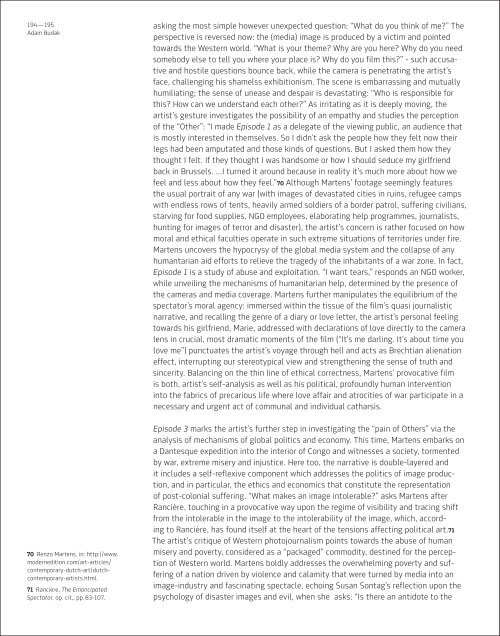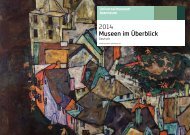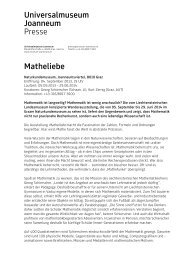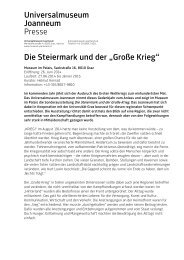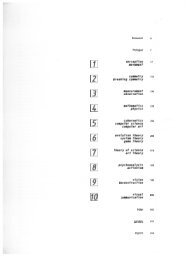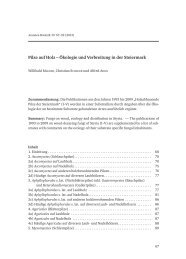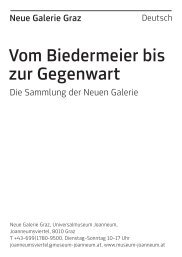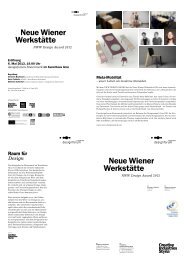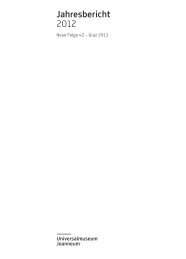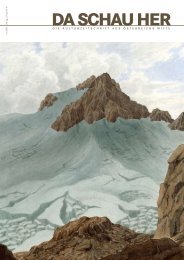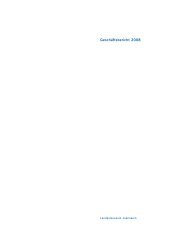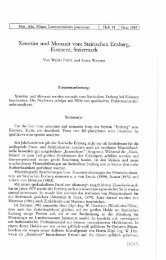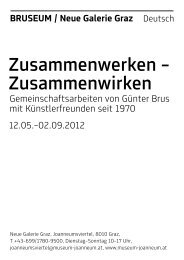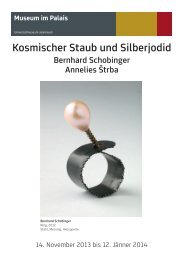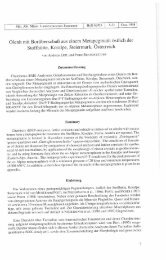Human Condition - Universalmuseum Joanneum
Human Condition - Universalmuseum Joanneum
Human Condition - Universalmuseum Joanneum
Erfolgreiche ePaper selbst erstellen
Machen Sie aus Ihren PDF Publikationen ein blätterbares Flipbook mit unserer einzigartigen Google optimierten e-Paper Software.
194 — 195<br />
Adam Budak<br />
70 Renzo Martens, in: http://www.<br />
modernedition.com/art-articles/<br />
contemporary-dutch-art/dutchcontemporary-artists.html.<br />
71 Rancière, The Emancipated<br />
Spectator, op. cit., pp. 83-107.<br />
asking the most simple however unexpected question: “What do you think of me?” The<br />
perspective is reversed now: the (media) image is produced by a victim and pointed<br />
towards the Western world. “What is your theme? Why are you here? Why do you need<br />
somebody else to tell you where your place is? Why do you film this?” - such accusative<br />
and hostile questions bounce back, while the camera is penetrating the artist’s<br />
face, challenging his shamelss exhibitionism. The scene is embarrassing and mutually<br />
humiliating; the sense of unease and despair is devastating: “Who is responsible for<br />
this? How can we understand each other?” As irritating as it is deeply moving, the<br />
artist’s gesture investigates the possibility of an empathy and studies the perception<br />
of the “Other”: “I made Episode 1 as a delegate of the viewing public, an audience that<br />
is mostly interested in themselves. So I didn’t ask the people how they felt now their<br />
legs had been amputated and those kinds of questions. But I asked them how they<br />
thought I felt. If they thought I was handsome or how I should seduce my girlfriend<br />
back in Brussels. ...I turned it around because in reality it’s much more about how we<br />
feel and less about how they feel.”70 Although Martens’ footage seemingly features<br />
the usual portrait of any war (with images of devastated cities in ruins, refugee camps<br />
with endless rows of tents, heavily armed soldiers of a border patrol, suffering civilians,<br />
starving for food supplies, NGO employees, elaborating help programmes, journalists,<br />
hunting for images of terror and disaster), the artist’s concern is rather focused on how<br />
moral and ethical faculties operate in such extreme situations of territories under fire.<br />
Martens uncovers the hypocrysy of the global media system and the collapse of any<br />
humantarian aid efforts to relieve the tragedy of the inhabitants of a war zone. In fact,<br />
Episode 1 is a study of abuse and exploitation. “I want tears,” responds an NGO worker,<br />
while unveiling the mechanisms of humanitarian help, determined by the presence of<br />
the cameras and media coverage. Martens further manipulates the equilibrium of the<br />
spectator’s moral agency: immersed within the tissue of the film’s quasi journalistic<br />
narrative, and recalling the genre of a diary or love letter, the artist’s personal feeling<br />
towards his girlfriend, Marie, addressed with declarations of love directly to the camera<br />
lens in crucial, most dramatic moments of the film (“It’s me darling. It’s about time you<br />
love me”) punctuates the artist’s voyage through hell and acts as Brechtian alienation<br />
effect, interrupting our stereotypical view and strengthening the sense of truth and<br />
sincerity. Balancing on the thin line of ethical correctness, Martens’ provocative film<br />
is both, artist’s self-analysis as well as his political, profoundly human intervention<br />
into the fabrics of precarious life where love affair and atrocities of war participate in a<br />
necessary and urgent act of communal and individual catharsis.<br />
Episode 3 marks the artist’s further step in investigating the “pain of Others” via the<br />
analysis of mechanisms of global politics and economy. This time, Martens embarks on<br />
a Dantesque expedition into the interior of Congo and witnesses a society, tormented<br />
by war, extreme misery and injustice. Here too, the narrative is double-layered and<br />
it includes a self-reflexive component which addresses the politics of image production,<br />
and in particular, the ethics and economics that constitute the representation<br />
of post-colonial suffering. “What makes an image intolerable?” asks Martens after<br />
Rancière, touching in a provocative way upon the regime of visibility and tracing shift<br />
from the intolerable in the image to the intolerability of the image, which, according<br />
to Rancière, has found itself at the heart of the tensions affecting political art.71<br />
The artist’s critique of Western photojournalism points towards the abuse of human<br />
misery and poverty, considered as a “packaged” commodity, destined for the perception<br />
of Western world. Martens boldly addresses the overwhelming poverty and suffering<br />
of a nation driven by violence and calamity that were turned by media into an<br />
image-industry and fascinating spectacle, echoing Susan Sontag’s reflection upon the<br />
psychology of disaster images and evil, when she asks: “Is there an antidote to the


